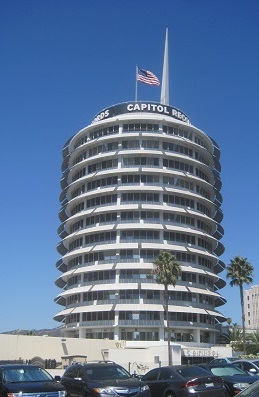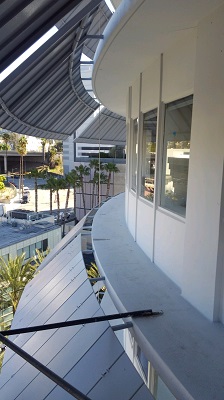Capitol Records, a label for musicians including the Eagles, Katy Perry, and NE-YO, is headquartered in a 13-story circular tower in the Hollywood neighborhood of Los Angeles, California. The landmark building, seen by commuters and tourists from nearby Route 101, had been leaking for years.
The work on the exterior concrete and metal awnings took place in early 2019, but for coatings contracting firm Raider Painting, the project started almost a decade earlier. Capitol Records reached out to Raider about the potential project, but the label wasn’t quite ready to hit the record button. As a result, Raider became familiar with the project, and the two developed a rapport.
According to Raider Painting’s CEO Allen Tabrizi, that open communication formed a connection, which is how they ended up getting the job — and others like it. “I can’t tell you the number of projects that we get because of that, especially if they’re interesting projects or very complicated [ones] that need personal attention,” he said.
This project covered 51,000 square feet (4,738.1 m2). It took a 12-person crew about four months over a six-month span to complete due to meetings, as well as the setup and breakdown of scaffolding from a third-party vendor.
Monster Hit
Built in 1956, the historic tower gave Raider Painting several unique challenges. The concrete core is surrounded by windows and antiquated movable sunshades, according to Tabrizi. The scaffolding gained the crew vertical access, but they had to figure out how to reach the concrete ledge at each level.
 “We physically had to get to these spaces, and that was the most difficult thing. Again, it’s an old building, so the whole building needed to be addressed. It wasn’t just a paint job. It needed to be anchored, so it would last a while and as long as possible,” Tabrizi explained. “So every square inch needed to be accessed physically — not just with a stick.”
“We physically had to get to these spaces, and that was the most difficult thing. Again, it’s an old building, so the whole building needed to be addressed. It wasn’t just a paint job. It needed to be anchored, so it would last a while and as long as possible,” Tabrizi explained. “So every square inch needed to be accessed physically — not just with a stick.”
The crew tried different strategies until they figured out the best approach. “There were all kinds of ‘Well, what if we do this?’ and ‘How can we do that?’ questions,” Tabrizi said. “And slowly but surely, all were identified and answered, and we came up with a solid plan. The more you look at the building, the harder it gets. It’s not the other way around. That building is a real access monster.”
Due to its location, another concern came from passersby. “The closer you get to the heart of LA and prying eyes, the worse it gets because everybody wants a piece of the action,” Tabrizi explained.
Looky-loos can be troublesome, too. “The loading dock was easily accessible, but we had constant problems with people that needed to move, access to loading docks, access to streets. It’s never ending,” Tabrizi said. Raider Painting used project managers on the ground to manage public relations and the client’s expectations and to coordinate all of that with the project managers. They also had a safety officer who visited once or twice a week as well as office team members helping to “pick up the pieces,” as Tabrizi explained.
Application Measures
Once exterior access was figured out, the Raider crew started in on the standard prep: removing loose material, pressure washing the surfaces, and handling any cracks.
Working from the top down on each circular story, the crew washed the building with 3,000 psi (20.7 MPa) blasters, followed by caulking all joints and applying a patch compound with a trowel on smaller cracks. For larger cracks, degraded areas, and spider cracks, the crew used the elastomeric coating to protect the area, usually southernly exposed. Those areas received an epoxy patch, full layer of an elastomeric primer, and topcoat. “And it holds it all together like a glove,” Tabrizi said.
All other areas received a full basecoat, EFF-STOP, and topcoat, Sparta Shield—Flat, both by Dunn-Edwards. The basecoat was applied in one to two coats at an average of 5.5 mils (139.7 microns) per coat using a Graco airless sprayer, brush, and roller. The topcoat was applied to an average of 3.6 mils (91.4 microns) in two coats minimum using the same equipment. The louvers were lightly profiled before receiving two coats of Sherwin-Williams’ SHER-LOXANE 800 at 5–7 mils (127.0–177.8 microns), again sprayed, brushed, and rolled.
After some back and forth within the client’s team and some suggestions from Raider Painting, the finish color was a formula match and appropriately named Capitol Records.
The Raider crew didn’t need 100 percent containment with the materials, so they used a fine mesh called ‘green screens,’ which were installed by the scaffolding company around the exterior of the equipment. “It keeps all the contaminants — dust, and chips, and whatever — away from the public; it just keeps it in our environment,” Tabrizi said.
The crew also collected the water by catching it with sandbags and letting it evaporate per the local laws, so as not to enter the water basins. “We actually started doing this about 14 or 15 years ago when we first found out about the new laws that were being implemented regarding zero tolerance, and it’s worked great since,” Tabrizi said. “We’ve had no issues, and we’ve always been successful in the outcome.”
Water affected the crew in another way, though. The delays from a particularly rainy season were “uncomfortable,” according to Tabrizi. “The humidity level alone and the moisture in the air was killing us. I think we lost a good three weeks,” he said. But the Raider Painting crew stayed out of harm’s way from any lightning. They also wore harnesses, lanyards, and eye and ear protection, and they held daily tailgate meetings.
Talented Team
 Raider Painting’s supporting staff allowed the eight painters to get the job done to the best of their abilities — some 20 to 30 years in the making. “These are talented people,” Tabrizi said succinctly.
Raider Painting’s supporting staff allowed the eight painters to get the job done to the best of their abilities — some 20 to 30 years in the making. “These are talented people,” Tabrizi said succinctly.
The client had a great ensemble, too. According to Tabrizi, Capitol Records has “an awesome group of people. You would figure they’d be high maintenance and difficult to work with, and it was just the opposite.” That isn’t always the case on a high-profile coatings job, so it was a pleasant surprise for Raider Painting. “These guys that run the building and the entire Capitol Records portfolio there in that building are just super people. I was surprised. I mean, I felt like I was working with my family and friends. They were very pliable, very flexible,” Tabrizi reiterated.
Working on unique projects such as the Capitol Building makes Tabrizi passionate, but once the project gets going, he said, the team has to focus in on the job at hand. “During the project, it doesn’t matter what building it was. At the beginning, it’s nostalgic, it’s amazing, it’s wow! We’ve got this cool building we’re working on, and then you recognize it again at the end: ‘Look! We did Capitol Records,’” he said. But Tabrizi explained that during the project, the crew has to focus on the client being happy, their own safety, and the accuracy of the application. It could be any project at that point. “And now, of course, you can look over your shoulder and say, ‘Look at that building; I did it,’” he said.
Despite the challenges, the Raider Painting crew was able to complete the recoating successfully. As Tabrizi put it, “The idiosyncrasies of the project were vast.” The passersby seem happy with how the building turned out. They’re saying “Oh! How wonderful it looks now!” Tabrizi said. And, more importantly, Capitol Records is happy with Raider’s work. That’s a solid gold hit!